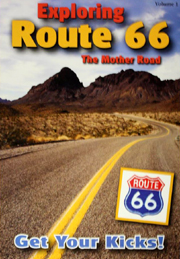David Bowyer’s new DVD documentary, “Exploring Route 66: The Mother Road,” doesn’t explore the entire length of Route 66 — hence the subtitle “Volume 1” that hints of future editions. But it proves to be a worthwhile addition to a roadie’s video library, especially for those who love the desert Southwest.
 “Exploring Route 66” takes on about 700 miles of Route 66, from the Continental Divide in western New Mexico to the Pacific Ocean in Santa Monica, California. Heading west, the film touches on just about every significant town on the route — albeit briefly because of the film’s brisk one-hour length.
“Exploring Route 66” takes on about 700 miles of Route 66, from the Continental Divide in western New Mexico to the Pacific Ocean in Santa Monica, California. Heading west, the film touches on just about every significant town on the route — albeit briefly because of the film’s brisk one-hour length.
Bowyer spent about three years talking to locals and shooting footage for “Exploring Route 66.” He sprinkled the film’s footage with interviews and added brief history about the Mother Road’s rise, fall and renaissance.
He plans to produce another film that explores the rest of Route 66, from Chicago to Albuquerque.
A few observations about the film:
— “Exploring Route 66” ends up with some of its best moments off the Mother Road, ironically. The side trips — especially Monument Valley, Supai Falls and one sequence in Las Vegas — prove compelling. In Supai, a town at the bottom of the Grand Canyon that receives almost all its supplies by pack mule, an old-timer says a piano even was hauled on the mountain trail by the animals. And Bowyer shoots exciting footage of the Treasure Island Pirate Show in Vegas, including the captain literally going down with his sinking ship.
— The film’s colors are super-saturated, making the region appear more vivid than it already is. The footage from Monument Valley, with its images of a Native American playing a flute amid majestic mesas and shepherds guiding sheep through a humongous hole in an even more humongous red rock, are particularly breathtaking. And images from Route 66 — many of them basking in the golden light of a late-afternoon sun — look terrific. Some may find the Kodachrome-type colors jarring, but I found them proper for the subject.
— The film’s musical accompaniment primarily comes from guitar-playing country-and-western singers who live on or near the Mother Road. The music brings a natural feel, especially during a performance of “Along the Navajo Trail” with the Monument Valley sequence. Other parts of “Exploring Route 66” use music scores that feel like they come from old-fashioned westerns.
— Bowyer’s identifying subtitles for his interview subjects often lacked context. I recognized Angel “Guardian Angel of Route 66” Delgadillo and Seligman Sundries co-owner Frank Kocevar. But didn’t know who Buck Williams or many other interviewees were. I often didn’t know whether they were historians, business owners, musicians, or dishwashers. Worse, my high-definition television clipped off the bottom 15 percent of the film’s image and, thus, many of those subtitles. The formatting problem didn’t occur on my PC.
— Bonus material was a 20-minute film by Bowyer, “Jeeping God’s Country,” which provides highlights for those who want to go off-roading in the mountains of the Four Corners area.
— The DVD is formatted to play in all regions so viewers in Europe, the United States and elsewhere can enjoy it — a thoughtful gesture.
(Among the places where the DVD can be purchased is Angel Delgadillo’s gift shop and Seligman Sundries in Seligman, Arizona; Standin’ on a Corner gift shop in Winslow, Arizona; Powerhouse Museum gift shop in Kingman, Arizona; Addicted to 66 and Cruiser’s in Williams, Arizona; Fast Fanny’s in Oatman, Arizona; and the Ash Fork Route 66 Museum in Ash Fork, Arizona.)
a great dvd. cannot wait for volume 2. regards graeme & glenys, melbourne, australia